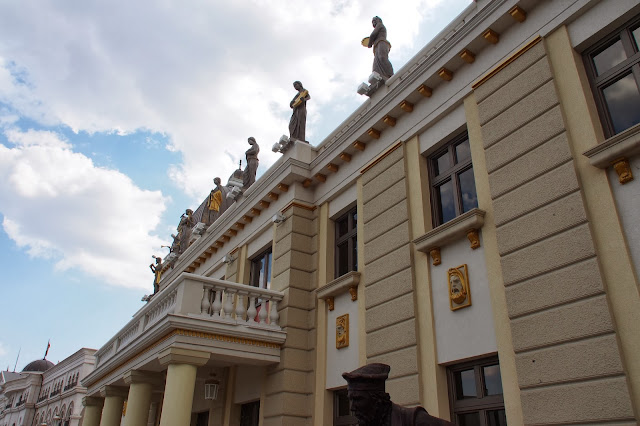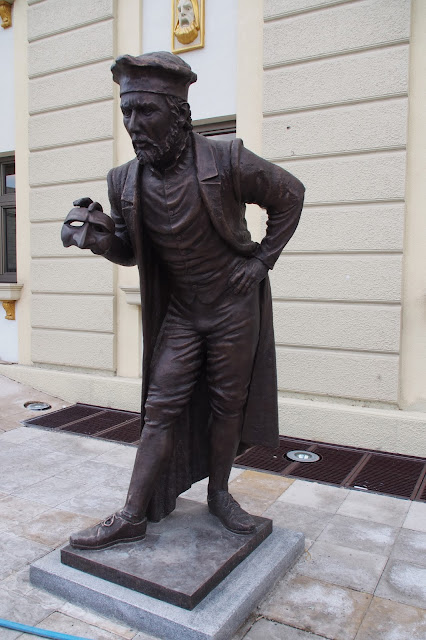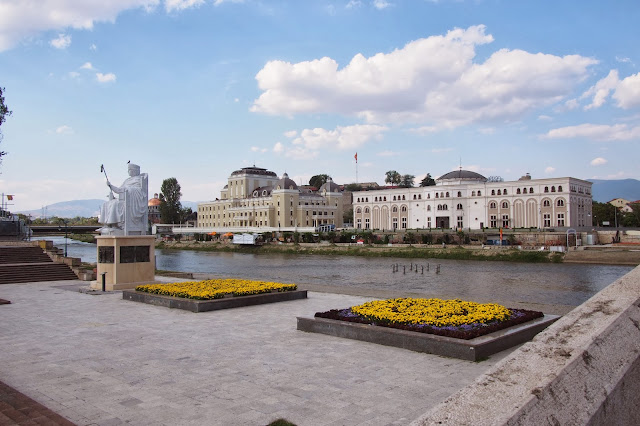After Ohrid, it's another 178 Km before we'd arrive at our next destination, Skopje, located on the upper course of the Vardar River, on a major
north-south Balkan route between Belgrade and Athens. It is a center for
metal-processing, chemical, timber, textile, leather, and printing
industries. Industrial development of the city is matched by growth in trade, logistics, and banking as well as culture and sport. According to the last
official count from 2002, Skopje has a population of 506,926 inhabitants
but according to two unofficial estimates for more recent period, the
city has a population of 668,518 or 491,000 inhabitants. Seismic
movements have formed medium-sized mountains around the city. It's
bordered by Šar Mountains to the west, by the Jakupica chain to the
south, and by hills to the east that form the early Osogovo Mountains,
which are situated on the border between Macedonia and Bulgaria.
Our rest stop
Another small town we passed by
the Turkish influence is very strong. you find Muslim minarets everywhere.
We passed through endless fields like this
Our restaurant
After the long journey, we were famished. Having nothing to do, I took this cruet stand with some Macedonian patterns
Our salad
Our main dish
Our bread
Our table mate's fish
The window of our restaurant
A shelf full of carvings of local saints
traditional Macedonia clothes on the wall above the entrance of the restaurant
Beautiful carved shades
Our local tour guide and our driver
There was a birthday celebration at our next table
A happy little girl
The happy little girl and her younger sister
A glum looking elder brother and his happy grandpa. Perhaps the boy is sulking because everybody's attention is centred on his sister?
Local kitchen ware
Pots, trays and jugs
a fountain blessed by a saint
Pots, jugs etc.blessed by another saint
quaint local male attire
a fancy treasure chest
Wheels and jugs
After lunch we were on our way again
A mosque we passed
A local lion before entering Skopje, located at the centre of the Balkans, approximately halfway between
Belgrade and Athens. The Vardar River, which originates near Gostivar,
flows through the city then flows south passing the border into Greece
and eventually flowing into the Aegean Sea. The Vardar valley consists
primarily of hills and mountains.
The Kale (Turkish for "fortress" ) of Skopje taken from our coach. In Macedonian, it's called Скопје. It's the capital and largest city of the Republic of Macedonia, its political, cultural, economic, and academic center. Known in Roman times as Scupi, it has been inhabited since at least 4000 BC ( from remains of Neolithic settlements found within the old Kale Fortress that overlooks the modern city centre). On the eve of the 1st century AD, the settlement was seized by the Romans and became a military camp.When the Roman Empire was split into eastern and western halves in 395 AD, Scupi came under Byzantine rule from Constantinople. During much of the early medieval period, the town was contested between the Byzantine and the Bulgarian Empires, being the Bulgarian capital for 20 years from 972 to 992.
From 1282, the town became part of the Serbian Empire and its capital from 1346. It was conquered by the Ottoman Turks in 1392, who renamed it Üsküp. It remained under Turkish control more than 5 centuries until 1912, serving as the capital of Pashasanjak of Üsküb and later the Vilayet of Kosovo. At that time the city was famous for its oriental architecture.
In 1912, it was annexed by the Kingdom of Serbia during the Balkan Wars and after the First World War the city became part of the newly formed Kingdom of Serbs, Croats and Slovenes (Kingdom of Yugoslavia).
In the Second World War the city was conquered by the Bulgarian Army, as part of Axis powers. Skopje was liberated on 13 November 1944 by Yugoslav Partisan units of the Macedonian National Liberation Army, together with units of the newly allied Bulgarian People's Army (Bulgaria having switched sides in the war in September). In 1944, it became the capital city of Democratic Macedonia (later Socialist Republic of Macedonia) and part of Democratic Federal Yugoslavia (later Socialist Federal Republic of Yugoslavia). The city developed rapidly after World War II, but this trend was interrupted in 1963 when it was hit by a disastrous earthquake.
In 1991, it became the capital city of an independent Macedonia.
Two-thirds of Skopje's population are Macedonians, and one third Albanians with less than 4% Roma people and 3% Serbians.
Among the minorities, the Albanians enjoy a privileged status because of their number. Albanian language can be used in local government and primary schools, and is official in the municipalities where at least 25% of the population is Albanian-speaking, in addition to the Macedonian official language.
The two religions that have had the greatest influence on the city are Orthodox Christianity, represented by the Diocese of Skopje, under the Macedonian Orthodox Church, and Islam. There also are smaller minorities of Catholics, Protestants and Jews.
From 1282, the town became part of the Serbian Empire and its capital from 1346. It was conquered by the Ottoman Turks in 1392, who renamed it Üsküp. It remained under Turkish control more than 5 centuries until 1912, serving as the capital of Pashasanjak of Üsküb and later the Vilayet of Kosovo. At that time the city was famous for its oriental architecture.
In 1912, it was annexed by the Kingdom of Serbia during the Balkan Wars and after the First World War the city became part of the newly formed Kingdom of Serbs, Croats and Slovenes (Kingdom of Yugoslavia).
In the Second World War the city was conquered by the Bulgarian Army, as part of Axis powers. Skopje was liberated on 13 November 1944 by Yugoslav Partisan units of the Macedonian National Liberation Army, together with units of the newly allied Bulgarian People's Army (Bulgaria having switched sides in the war in September). In 1944, it became the capital city of Democratic Macedonia (later Socialist Republic of Macedonia) and part of Democratic Federal Yugoslavia (later Socialist Federal Republic of Yugoslavia). The city developed rapidly after World War II, but this trend was interrupted in 1963 when it was hit by a disastrous earthquake.
In 1991, it became the capital city of an independent Macedonia.
Two-thirds of Skopje's population are Macedonians, and one third Albanians with less than 4% Roma people and 3% Serbians.
Among the minorities, the Albanians enjoy a privileged status because of their number. Albanian language can be used in local government and primary schools, and is official in the municipalities where at least 25% of the population is Albanian-speaking, in addition to the Macedonian official language.
The two religions that have had the greatest influence on the city are Orthodox Christianity, represented by the Diocese of Skopje, under the Macedonian Orthodox Church, and Islam. There also are smaller minorities of Catholics, Protestants and Jews.
There are double decker buses in Skopje too
The fort from another angle. This fortress was originally built by the Byzantines in the
6th century but after 1963 Skopje earthquake, the fortress's circular,
rectangular and square towers were conserved and restored.
The new Philharmonic Theatre, part of the €500 million "Skopje
2014" project"which aims to give a more monumental appearance to the
capital, including statues, fountains, bridges, and museums, launched by the government in 2010. Apart from this, a
number of new buildings are being constructed along the River Vardar,
including the museum of archaeology. It has a rather loose town
planning, which is the result of an earthquake that destroyed 80% of the
city in 1963. Rebuilding after the earthquake was largely orchestrated by
Kenzo Tange, a Japanese architect and urban planner who had drawn many
plans for cities and towns including that for Hiroshima in 1949.
The
most significant accomplishment was the train station, which was built
on an elevated platform over bridges and allows for the separation of
traffic and pedestrians. The new
government elected in July 2006 restored the Kale Fortress and plans to
rebuild the beautiful 19th century Army House, the Old National Theatre,
and the Old National Bank of Macedonia — all destroyed in the 1963
earthquake. It also plans to to build the "Macedonian
Struggle" Museum, the Archeological Museum of Macedonia, National
Archive of Macedonia, Constitutional Court, and a new Philharmonic
Theater.As part of the project, there will be monuments to the some most
famous figures in Macedonian history. The project is set to be
completed by 2015. But the project has generated much
controversy: critics say the new landmark buildings show reactionary
historicist aesthetic, costs too much and there's no representation of
national minorities in the coverage of its set of statues and memorials
and that it's turning Skopje to a theme park, a nationalistic kitsch and
an example of how national identities are constructed.

A fuller view of the theatre. Every year since 1972, Skopje holds the May Opera Evenings, a festival dedicated to promoting opera among the general public. Over the years, it has evolved into a stage on which artists from some 50 countries have performed. Another opera festival, the Open Youth Theatre Festival, was established in May 1976 by a group of young opera enthusiasts. More than 250 theatrical performances have been presented at this festival so far, most of them being alternative, experimental theatre groups engaging young writers and actors. Recently, the festival became a member of the Brussels Informal European Theatre Meeting (IETM). Within the framework of the Open Youth Theatre, a Macedonian National Centre of the International Theatre Institute (ITI) was established, and at the 25th ITI World Congress in Munich in 1993, it became a regular member of the theatre association. The festival is now an international festival with representatives from the former Yugoslavia, the United States, France, the former Soviet Union, Spain, Japan, Poland, Italy, the United Kingdom, India and other countries.
An opera singer
His counterpart
A dancing couple
Lady with the lyre
Alexander the Great
The archaeological museum, also part of the Skopje 2014 Project
Another view of the museum and its surroundings
New hotel and shopping complex opposite to the museum or are they part of the "Macedonian
Struggle" Museum or the National
Archive of Macedonia?
Two national historic figures St. Clement and St. Methodius?
Another two. Goce Delcev and
Dame Gruev?
Alexander?
More national heroes
Who is this, I wonder
Another local monument, I forgot what it was on the Old Stone Bridge,built on Roman foundations under the patronage of Sultan Mehmed II the
Conqueror between 1451 and 1469. This bridge represents the connection
between Skopje's past and present, and is featured in the Coat of arms
of Skopje.The bridge connects Skopje's main square, Macedonia
Square, to the city's Old Bazaar. The square was dramatically increased
in size by the destruction of the massive neoclassical National Bank and
Army House during the 1963 earthquake.Throughout the centuries, the Stone Bridge was often damaged and then repaired. There is historical evidence that it once suffered during the great earthquake of 1555 which heavily damaged or destroyed four pillars. In 1944, explosives were placed on the bridge by Nazis. When Skopje was liberated, the activation of the explosives was prevented and the bridge was saved from destruction. Some executions have also taken place on this bridge, such as the execution of Karposh in 1689 which unearthed some relics.
One of the new bridges across the Vardar. The center of Skopje consists of two municipalities
separated by the Vardar River. On the north bank of the river is Čair
Municipality, in which the Old Town is located, while the on the south
bank is Centar Municipality, which is the modern part of the center of
the city.
statues of modern day ladies
A close up of one of them
We were taken to a church commemorating Mother Teresa. She was born here.
Her statue
beautiful smooth lines in a prayerful position
The Memorial House of Mother Teresa, opened in early 2009.
A light bulb above the church
The streets are full of skulptures
A raging bull in street of modern shops and restaurants
a book stand
handicraft for sale by the roadside
The city museum. It used to be the old train station. It's clock shows permanently the time the disastrous 1963 6.1 Richter scale earthquake struck and destroyed the city.
Ancient tombstone
a sarcogaphus outside the museum
Another one
The porch to the museum
leaves turning red
Another bronze statue
There were a lot of construction going on at the new part of this town
Everywhere I went, I saw flowers
A church being built or renovated?
Another statue
Acrobats or soldiers? Any real difference?
Alexander on horse back above city lamp posts
Diogenes?
Our tour guide below the city fountain
Soldiers defending the city?
The huge Macedonia Square
A little girl and her brother by the fountain
a national hero?
Can't read, who is he?
Another groups of statues
the old stone bridge
A lady preparing to take a dive after the other already in the water
There were a number of anglers trying their luck
Another view of the bridge
Some interesting reflections
The square from another perspective
A king seated beside the river
Clouds above the city
Another fountain of maternal love
Close up on mother and child
How proudly he stands, arm raised back to the Arabian quarters The
largest concentration of the mosques in the city is in the Old Bazaar, a
part of the city with typical Ottoman Islamic architecture. One of the
most eminent mosques is the Mustafa Pasha Mosque which was built in 1492
by Mustafa Paşa on an older Christian site.It was an endowment of
Mustafa Pasha, an eminent figure in the Turkish state during the rule
of Sultan Bayezid II and Sultan Selim.
This is the Old Town, one of the largest and most significant oriental bazaars
in the Balkan, on the eastern bank of the Vardar
River and features mosques, inns, a clocktower, a bezisten, Turkish baths,
churches, and various shops. The bezisten, a covered market, was built
in the 15th century by Gazi Ishak Bey, the Sultan's Skopje regent. It
was destroyed by a fire in 1689 and was later rebuilt. The bezisten has
looked the same since its renovation in 1899. Skopje's clock tower,
built in the 16th century on the foundations of an older edifice, is
located just north of the Sultan Murad Mosque
It has become a tourist attraction. In the background is the Isa Bey Mosque, situated on the outskirts of the bazaar. This
mosque was built as a memorial for Isa Bey, son of Ishak Bey and
grandson of Pasha Yigit Bey the Ottoman conqueror of Skopje, built in 1439 in the northern part of the Old
Bazaar. The mosque's minaret rises 30 meters (98.4 feet). Ishak Bey,
who retired in the city, is buried in the türbe behind the mosque.
Armour on sticks!
an old mosque,
Alexander from the Arabian angle, looking forward
The sun was setting
Time for a coffee after all that walking
Candle holders at the restaurant
Back to the old bridge leading to the Arab quarters, where we were supposed to re-group
The archaeological museum in the sunset
the old bridge in the sunset
What buildings are these, we weren't told, museums?
Older buildings nearby
Ah, a wedding
The tense but happy bride and the proud groom
My final view of the city. According to the Wikipedia, the city has several universities. The largest and the oldest is the Ss.
Cyril and Methodius University. This public university was founded in
1949 with three faculties. Since then, it has expanded to 23 faculties,
10 institutes, and over 36,000 students. Since the independence of
Macedonia, new universities, mostly private, have been opened. The
European University was established in 2001 and has faculties of
economics, computer science, law, political science and art and
design.FON University, founded in 2003, has faculties of law, political
science and international relations, foreign languages, investigation
and security, environmental management, economics, technology and
communication information, sports, design and multimedia and philosophy.
The American University College was opened in 2005 and has faculties of
business administration, political science, foreign languages,
architecture and design, computer science and law.The Yahya Kemal
College, named after the Turkish poet Yahya Kemal Beyatlı who was born
in Skopje, opened in 1996.In 2008, Skopje had 21 colleges.












































































































沒有留言:
張貼留言